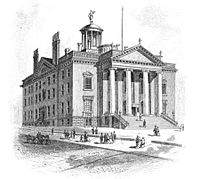|
54th New York State Legislature
The 54th New York State Legislature, consisting of the New York State Senate and the New York State Assembly, met from January 4 to April 26, 1831, during the third year of Enos T. Throop's governorship, in Albany. BackgroundUnder the provisions of the New York Constitution of 1821, 32 senators were elected on general tickets in eight senatorial districts for four-year terms. They were divided into four classes, and every year eight Senate seats came up for election. Assemblymen were elected countywide on general tickets to a one-year term, the whole Assembly being renewed annually. State Senator Moses Hayden died on February 13, 1830, leaving a vacancy in the Eighth District. At this time, there were three political parties: the Jacksonians (supporting President Andrew Jackson; led by U.S. Secretary of State Martin Van Buren), the Anti-Masons, and the National Republicans (supporting Henry Clay for the presidency). The Anti-Masonic state convention met in August 1830 at Utica, and nominated Assemblyman Francis Granger for governor, and Samuel Stevens, of New York City, for lieutenant governor. The National Republicans did not call a convention, and supported the Anti-Masonic ticket. The Jacksonian state convention met on September 8, 1830, at Herkimer and nominated Gov. Throop for re-election, and Edward P. Livingston for lieutenant governor. ElectionsThe State election was held from November 1 to 3, 1830. Gov. Enos T. Throop was re-elected, and Edward P. Livingston was elected lieutenant governor. State Senator Jonathan S. Conklin (1st D.) was re-elected. David M. Westcott (2nd D.), William I. Dodge (4th D.), Henry A. Foster (5th D.), Charles W. Lynde (6th D.), William H. Seward (7th D.), Trumbull Cary (8th D.); and Assemblymen Herman I. Quackenboss (3rd D.) and Philo C. Fuller (8th D.) were also elected to the Senate. Lynde, Seward, Cary and Fuller were Anti-Masons, the other five were Jacksonians. SessionsThe Legislature met for the regular session at the Old State Capitol in Albany on January 4, 1831; and adjourned on April 26. George R. Davis (J) was elected Speaker with 91 votes against 30 for John C. Spencer (A-M). On January 6, Cary and Fuller drew lots to decide which one of the two senators elected in the 8th District would serve the short term, and which one the full term. Fuller drew the short term, and Cary the full term.[1] On February 1, the Legislature elected Supreme Court Justice William L. Marcy (J) to succeed Nathan Sanford as U.S. Senator for a six-year term beginning on March 4, 1831. On February 1, the Legislature re-elected State Treasurer Abraham Keyser, Jr. On June 3, a National Republican state convention met at Albany, Peter R. Livingston was Chairman. The convention chose delegates to the National Republican national convention which would nominate Henry Clay for U.S. president, among them Stephen Van Rensselaer and Ambrose Spencer. State SenateDistricts
Note: There are now 62 counties in the State of New York. The counties which are not mentioned in this list had not yet been established, or sufficiently organized, the area being included in one or more of the abovementioned counties.
MembersThe asterisk (*) denotes members of the previous Legislature who continued in office as members of this Legislature. Herman I. Quackenboss and Philo C. Fuller changed from the Assembly to the Senate.
Employees
State AssemblyDistricts
Note: There are now 62 counties in the State of New York. The counties which are not mentioned in this list had not yet been established, or sufficiently organized, the area being included in one or more of the abovementioned counties.
AssemblymenThe asterisk (*) denotes members of the previous Legislature who continued as members of this Legislature. The party affiliations follow the vote for U.S. Senator and state treasurer.[4] Employees
Notes
Sources
|
|||||||||||||||||||||||||||||||||||||||||||||||||||||||||||||||||||||||||||||||||||||||||||||||||||||||||||||||||||||||||||||||||||||||||||||||||||||||||||||||||||||||||||||||||||||
Portal di Ensiklopedia Dunia
